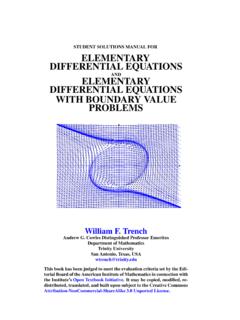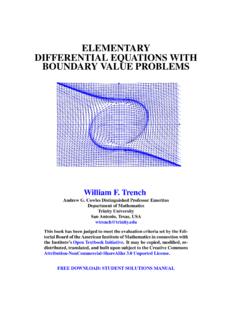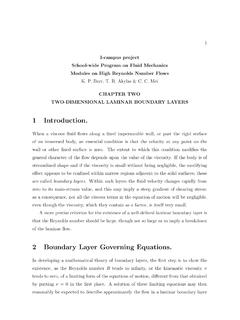Transcription of Numerical Solution of the Falkner- Skan Equation Using ...
1 Numerical Solution of the Falkner- Skan Equation Using Third-Order and High-Order-Compact Finite Difference Schemes J. of the Braz. Soc. of Mech. Sci. & Eng. Copyright 2011 by ABCM October-December 2011, Vol. XXXIII, No. 4 / 381 Carlos Duque-Daza Universidad Nacional de Colombia Department of Mechanical Engineering 111321 Bogot , Colombia Duncan Lockerby University of Warwick Fluid Dynamics Research Centre School of Engineering CV4 7AL Coventry, UK Carlos Galeano Universidad Nacional de Colombia Department of Mechanical Engineering 111321 Bogot , Colombia Numerical Solution of the Falkner- Skan Equation Using Third-Order and High-Order-Compact Finite Difference Schemes We present a computational study of the Solution of the Falkner- Skan Equation (a third-order boundary value problem arising in boundary -layer theory) Using high-order and high-order-compact finite differences schemes.
2 There are a number of previously reported Solution approaches that adopt a reduced-order system of equations, and Numerical methods such as: shooting, Taylor series, Runge-Kutta and other semi-analytic methods. Interestingly, though, methods that solve the original non-reduced third-order Equation directly are absent from the literature. Two high-order schemes are presented Using both explicit (third-order) and implicit compact- difference (fourth-order) formulations on a semi-infinite domain; to our knowledge this is the first time that high-order finite difference schemes are presented to find Numerical solutions to the non-reduced-order falkner - Skan Equation directly. This approach maintains the simplicity of Taylor-series coefficient matching methods, avoiding complicated Numerical algorithms, and in turn presents valuable information about the Numerical behaviour of the Equation .
3 The accuracy and effectiveness of this approach is established by comparison with published data for accelerating, constant and decelerating flows; excellent agreement is observed. In general, the Numerical behaviour of formulations that seek an optimum physical domain size (for a given computational grid) is discussed. Based on new insight into such methods, an alternative optimisation procedure is proposed that should increase the range of initial seed points for which convergence can be achieved. Keywords: laminar boundary layer, similarity analysis, high-order-compact finite differences Introduction1 The Falkner- Skan Equation , originally derived in 1931, falkner and Skan (1931), is of central importance to the fluid mechanics of wall-bounded viscous flows. It is derived from the two-dimensional incompressible Navier-Stokes equations for a one-sided bounded flow Using a similarity analysis (see Cebeci and Bradshaw (1977)) and its Solution describes the form of an external laminar boundary layer in the presence of an adverse or favourable streamwise pressure gradient.
4 Despite the apparent simplicity of the Falkner- Skan Equation (a one-dimensional ordinary differential Equation ) solving it accurately can be fraught with difficulty; these problems mainly stem from its non-linearity and third-degree order. There are some examples of analytical solutions to the Falkner- Skan equations for special cases (see, , Fang and Zhang (2008) and Magyari and Keller (2000)), but most studies have focused either on demonstrating a Solution s existence and uniqueness or finding a Numerical /computational Solution for particular boundary -layer conditions. Results for Solution existence and uniqueness to the Falkner- Skan Equation can be found in Rosenhead (1963), Weyl (1942), Hartman (1972) and Tam (1970). In some of these works, ranges of validity for the boundary -layer parameters and similarity variable are established (see, , Pade (2003)).
5 More recently, Yang (2008) presents a non-existence result that places upper and lower bounds on, in essence, the non-dimensional wall shear stress. However, despite the amount of effort dedicated to this problem, this two-point boundary value problem still lacks a general closed-form Solution , and as such, Numerical treatments are the most common and valuable route for its study and Solution . Paper received 25 October 2010. Paper accepted 21 June 2011. Technical Editor: Fernando Rochinha A raft of computational approaches and methodologies have been presented for the Solution of the FS Equation , see for example Hartree (1937), Asaithambii (1997), Asaithambi (1998, 2004b, 2005), Abbasbandy (2007), Alizadeh et al. (2009) and Zhang and Chen (2009).
6 The most widely used and classical approach to Numerical Solution is to reduce the boundary value problem to an initial value problem via a shooting method (see Cebeci and Bradshaw (1977); Cebeci and Keller (1971) for a thorough discussion). This involves prescribing known conditions at the wall boundaries along with an estimate for the velocity profile s first derivative at the wall, which is successively refined until known far-field boundary conditions are satisfied. A recent development in shooting methods, presented by Liu et al. (2008), shows that, in fact, trial imposition of known boundary conditions is not necessary, as they can be formulated as unknowns of the Solution procedure. Even so, shooting methods have the significant disadvantage of being more time consuming, as they essentially solve two or more initial value problems during each iteration, Asaithambi (1998), requiring a larger amount of computational nodes and memory capacity than other approaches.
7 Another equally significant undesirable feature of shooting methods is their known convergence difficulties, which have to be overcome with modifications that significantly increase algorithm complexity, Asaithambi (2004b). To circumvent the need for a shooting algorithm, and the attendant difficulties and complexities related to it, finite-difference schemes (FDS) can be applied directly to the Falkner- Skan as a boundary - value problem ( not as an initial- value problem). Asaithambi (1998, 2004a) and Elbarbary (2005) applied low-order FDS (to a reduced-derivative-order Equation set), and obtained results in excellent agreement with those from shooting methods, despite the low-order approximation of the difference schemes adopted. Results for higher orders of accuracy have been found by Salama and Mansour (2005a,b) where FDS of fourth and sixth order are used to solve steady and unsteady two-dimensional laminar Duque-Daza et al.
8 382 / Vol. XXXIII, No. 4, October-December 2011 ABCM boundary -layer equations. However, in the works mentioned above, the original third-order boundary - value problem for the Falkner- Skan Equation is either transformed into a reduced system of a first- and a second-order Equation (to be solved by a coupled scheme) or solved Using other complex Numerical methods, some requiring additional adjustment coefficients to be calculated. In some cases, additional fictitious end points are added, depending on the accur- acy and range of applicability of the particular Numerical model proposed. Also, in addition to the mathematical complexity often involved, the Numerical methods proposed tend to require significant computational time, as noted by Asaithambi (1998) and Salama and Mansour (2005b). In the present work, we show how solutions to the original third-order Falkner- Skan boundary value problem (BVP) can be obtained Using FDS, without the need for complex and involved mathematical algorithms, and at a relatively low programming and computational cost compared to other approaches of the same accuracy.
9 Moreover, the approach presented in this paper is conceptually less complex, and at the same time able to obtain results with the same precision and bounding error limits as those previously reported. As such, the procedure is instructive and helpful, not just in terms of solutions to the Falkner- Skan equations, but to the direct application of FDS in cases where, normally, either a reduction of derivative order or an addition of fictitious end points would be required. The paper is structured as follows. In Section 1 the Falkner- Skan Equation is introduced and briefly discussed as a two-point boundary value problem, along with its characteristic boundary conditions. Section 2 details the modifications performed in the formulation of the Falkner- Skan Equation in order to make it suitable to the Numerical treatment of this paper.
10 In Sections 3, 4 and 5, two different implementations are presented, the first Using direct third- and fourth-order FDS, and the second Using a methodology based on high-order-compact finite differences. In Sections 6 to 9 Numerical results from the two schemes are presented and their accuracy discussed. Finally, in Section 10, some conclusions are drawn. Nomenclature f = velocity function f = vector with the values of f g = velocity function h = mesh size J = Jacobian matrix of Y N = number of discrete points in the approximation p = fluid pressure Re = Reynolds number of the air flow, Reynolds number U = free-stream velocity u = x component of velocity v = y component of velocity Y = set of non-linear equations Z = boundary condition function at 1= Greek Symbols = value of the second derivative of f at the wall = dimensionless pressure-gradient parameter = convergence criterion = dimensionless pressure-gradient parameter = fluid density = dimensionless spatial variable = accuracy order of the approximation = kinematic viscosity = dimensionless spatial variable = Falkner- Skan conventional stream function = dimensionless coordinate Subscripts = relative to infinite The Falkner- Skan Equation .
















